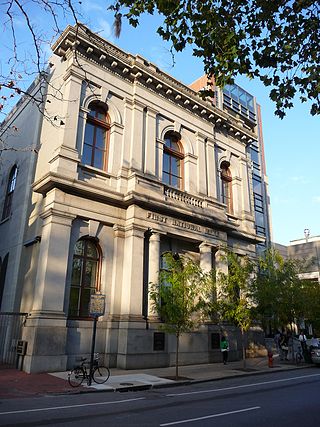
A charitable trust is an irrevocable trust established for charitable purposes. In some jurisdictions, it is a more specific term than "charitable organization". A charitable trust enjoys varying degrees of tax benefits in most countries and also generates goodwill. Some important terminology in charitable trusts includes the term "corpus", referring to the assets with which the trust is funded, and the term "donor," which is the person donating assets to a charity.

The time value of money is the widely accepted conjecture that there is greater benefit to receiving a sum of money now rather than an identical sum later. It may be seen as an implication of the later-developed concept of time preference.
The rule against perpetuities is a legal rule in common law that prevents people from using legal instruments to exert control over the ownership of private property for a time long beyond the lives of people living at the time the instrument was written. Specifically, the rule forbids a person from creating future interests in property that would vest beyond 21 years after the lifetimes of those living at the time of creation of the interest, often expressed as a "life in being plus twenty-one years". In essence, the rule prevents a person from putting qualifications and criteria in a deed or a will that would continue to affect the ownership of property long after he or she has died, a concept often referred to as control by the "dead hand" or "mortmain".
A structured settlement is a negotiated financial or insurance arrangement through which a claimant agrees to resolve a personal injury tort claim by receiving part or all of a settlement in the form of periodic payments on an agreed schedule, rather than as a lump sum. As part of the negotiations, a structured settlement may be offered by the defendant or requested by the plaintiff. Ultimately both parties must agree on the terms of settlement. A settlement may allow the parties to a lawsuit to reduce legal and other costs by avoiding trial. Structured settlements are most widely used in the United States, but are also utilized in Canada, England and Australia.

Pensacola Bay Center is an indoor arena located in Pensacola, Florida. It is owned by Escambia County and operated by ASM Global. The Bay Center has a capacity of 8,049 for hockey games, and as much as 10,000 for non-hockey events. The arena contains 23,000 square feet (2,100 m2) of space and 10,000 square feet (1,000 m2) of meeting space.

The Alerus Center is an indoor arena and convention center in the north central United States, located in Grand Forks, North Dakota. The facility is owned and operated by the city of Grand Forks and opened on February 10, 2001.

The Brookshire Grocery Arena is a 14,000-seat multi-purpose arena, in Bossier City, Louisiana. The naming rights were purchased by the company Brookshire Grocery Group of Tyler, Texas in 2021.

Fargodome is an indoor athletic stadium in the north central United States, located on the campus of North Dakota State University (NDSU) in Fargo, North Dakota. Opened 32 years ago in late 1992, the facility is owned by the City of Fargo and built on university land. Not an actual dome, its seating capacity is 18,700 for football and over 25,000 for full arena concerts. Its approximate elevation at street level is 900 feet (275 m) above sea level.

The Paul J. Meyer Arena, which is part of the Ferrell Center, is an arena in Waco, Texas. Built in 1988 and located adjacent to the Brazos River, it is home to the Baylor University Bears volleyball, acrobatics, and tumbling teams. It is named for Charles R. Ferrell, a Baylor student and legacy who died in 1967, and whose family's estate was a major benefactor of the arena. The building replaced the Heart O' Texas Coliseum as the school's primary indoor athletic facility. The men's and women's basketball teams relocated to the newly-constructed Foster Pavilion in 2024.
A celebrity bond is commercial debt security issued by a holder of fame-based intellectual property rights to receive money upfront from investors on behalf of the bond issuer and their celebrity clients in exchange for assigning investors the right to collect future royalty monies to the works covered by the intellectual property rights listed in the bond. Typically backed by music properties, the investment vehicle was pioneered in 1997 by rock and roll investment banker David Pullman through his $55 million David Bowie bond deal.

The Pettit National Ice Center is an indoor ice skating facility in Milwaukee, Wisconsin, featuring two international-size ice rinks and a 400-meter speed skating oval. Located adjacent to Wisconsin State Fair Park, the center opened on January 1, 1993, and was named for Milwaukee philanthropists Jane and Lloyd Pettit. Pettit National Ice Center Inc., a non-profit organization, has operated the site since the facility opened.

The UCCU Center, is a multi-purpose arena on the campus of Utah Valley University (UVU) in Orem, Utah, United States. It was built in 1996 and is home to the Utah Valley Wolverines basketball team.
In the United States, an annuity is a financial product which offers tax-deferred growth and which usually offers benefits such as an income for life. Typically these are offered as structured (insurance) products that each state approves and regulates in which case they are designed using a mortality table and mainly guaranteed by a life insurer. There are many different varieties of annuities sold by carriers. In a typical scenario, an investor will make a single cash premium to own an annuity. After the policy is issued the owner may elect to annuitize the contract for a chosen period of time. This process is called annuitization and can also provide a predictable, guaranteed stream of future income during retirement until the death of the annuitant. Alternatively, an investor can defer annuitizing their contract to get larger payments later, hedge long-term care cost increases, or maximize a lump sum death benefit for a named beneficiary.
Under European Union law, an annuity is a financial contract which provides an income stream in return for an initial payment with specific parameters. It is the opposite of a settlement funding. A Swiss annuity is not considered a European annuity for tax reasons.

Truist Arena, formerly The Bank of Kentucky Center and BB&T Arena, is a 10,000-seat multi-purpose arena in Highland Heights, Kentucky, on the campus of Northern Kentucky University. The arena was topped off on June 21, 2007, and the first event held there was NKU's graduation ceremony on May 10, 2008. A grand opening ceremony was held on September 22, 2008.
A life annuity is an annuity, or series of payments at fixed intervals, paid while the purchaser is alive. The majority of life annuities are insurance products sold or issued by life insurance companies however substantial case law indicates that annuity products are not necessarily insurance products.
A charitable remainder unitrust is an irrevocable trust created under the authority of the United States Internal Revenue Code § 664 ("Code"). This special, irrevocable trust has two primary characteristics: (1) Once established, the CRUT distributes a fixed percentage of the value of its assets to a non-charitable beneficiary ; and (2) At the expiration of a specified time, the remaining balance of the CRUT's assets is distributed to charity. The trustee determines the fair market value of the CRUT's assets at the time of contribution and thereafter on the applicable valuation date. The fixed annuity percentage must be at least 5% and no more than 50% of the fair market value of the assets in the corpus. The remainder must be at least 10% of the fair market value of the assets contributed to the CRUT. Code Section 664(d)(1) sets the federal income tax requirements for a charitable remainder unitrust.

Dickey–Stephens Park is a baseball park in North Little Rock, Arkansas, United States. The ballpark is primarily used for baseball and serves as the home for the Arkansas Travelers of the Texas League. The capacity of the ballpark is 7,300 which includes 5,800 fixed seats capacity and 1,500 on the berms. It opened in 2007 as a replacement for Ray Winder Field in Little Rock, Arkansas. The ballpark is named after four local Arkansas brothers: Baseball Hall of Famer Bill Dickey, former Major League Baseball catcher George Dickey, and businessmen Jackson T. Stephens and W. R. Stephens.
Income drawdown is a method withdrawing benefits from a UK Registered Pension Scheme. In theory, it is available under any money purchase pension scheme. However, it is, in practice, rarely offered by occupational pensions and is therefore generally only available to those who own, or transfer to, a personal pension.

First National Bank was a bank in Philadelphia. Chartered in 1863, it was the first national bank created under the banking reforms of the Civil War that began to define the modern U.S. banking system, and the first commercial bank to issue a federal banknote. It operated independently until 1955, when it was merged into the Bank of North America and Trust Company, which now is part of Wells Fargo.












